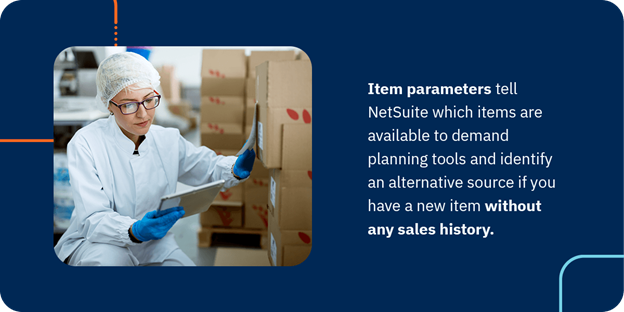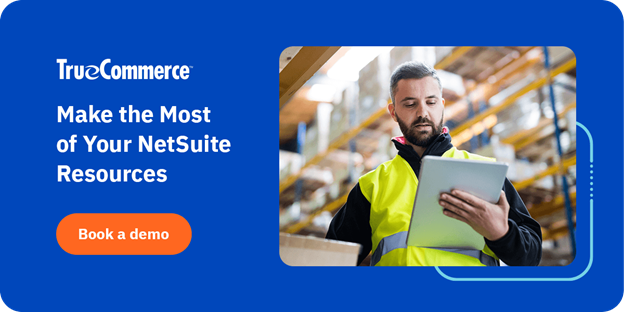NetSuite Supply Chain Management Best Practices

March 14, 2024
As with all business systems, getting the most out of NetSuite requires a thorough understanding of its features and tools. Whether you’re considering implementing this platform or already have it, following these best practices for NetSuite supply chain management can maximize the value of your investment to reduce costs, increase efficiency, and facilitate other benefits.
1. Use Advanced Inventory Management Features
Our first supply chain best practice for NetSuite is to dive into its Advanced Inventory Management (AIM) features. AIM provides granular control and visibility into your inventory, boosting accuracy and streamlining management tasks.
Some tasks in AIM to consider implementing in your workflow include:
- Demand-based inventory replenishment: AIM offers several tools for demand-based inventory replenishment that can help you reduce excess stock based on various data points. For instance, you can set reorder points and preferred stock levels based on factors such as seasonal or historical sales demand and average lead time. AIM also offers real-time alerts to help you take action and avoid stockouts.
- Inventory control: AIM’s many inventory control features allow you to manage and track items across multiple locations. If your products include varying colors, sizes, or styles, you can use matrix item management for easier pricing and SKU creation. Other tools include lot and bin management, serialized inventory, and automated cycle counting through NetSuite Smart Count.
- Inventory process management: AIM also supports inventory process management tasks through tools such as return merchandise authorization and pick, pack, and ship management. It can reduce administrative requirements for these core processes.
Many of these tools rely on data from other sources, so you’ll need to link them up with NetSuite, usually via electronic data interchange (EDI) or application programming interfaces (APIs). These systems help integrate information from your trading partners, such as distributors, suppliers, third-party logistics (3PL) providers, and other business systems. You’ll also want to use built-in process controls to ensure data integrity and avoid errors. Connections such as these help NetSuite work with the most accurate data and facilitate automation.
2. Maximize the Value of Demand Planning
Demand planning is a valuable tool in AIM that can help you avoid lost sales and obsolete inventory caused by overstocking and stockouts. NetSuite offers granular controls over how the demand planning algorithm treats different items and makes predictions.
NetSuite’s four projection methods are linear regression, moving average, seasonal average, and sales forecast. Each uses different types of data to make predictions. For the best accuracy, choose the projection method that best fits your business demands.
Another useful way to improve the results of your demand planning is to set up item parameters. These parameters tell NetSuite which items are available to demand planning tools and identify an alternative source if you have a new item without any sales history. Other parameters determine how to evaluate demand or generate planned orders. If you use NetSuite’s distribution resource planning tool to move items between locations, you can also use item parameters to identify which distribution network and category items belong to.

High-priority orders can complicate a demand forecast. If these impact your workflow, use allocation exceptions management to have NetSuite assess supply sources and manage allocations to focus on timely shipments of high-priority orders. Check out the intelligent supply reallocation recommendations to prioritize orders by redirecting resources from unallocated orders while mitigating adverse effects on customers.
By tailoring your demand planning resources to your inventory’s unique qualities, you can improve inventory levels, reduce overhead, and support a positive customer experience, all backed by the data in NetSuite.
3. Provide Ongoing Education for Your Team
NetSuite is a vast program, with many modules and features that can quickly become confusing or frustrating for users who lack training. These team members are also likely to make more errors, potentially increasing costs and damaging your reputation with partners and customers.
To avoid these effects, invest in initial and ongoing education. Your team should understand the features and functionalities of supply chain management in NetSuite. Provide special attention to the elements that various roles will use most often. For instance, you could offer warehouse team members a more in-depth course on inventory management tools while providing more training on demand planning to relevant administrators.
Follow up with training for updates to the system and refreshers. If you haven’t implemented NetSuite yet, include change management in your strategy to ensure team members understand the purpose of the solution and how it will impact and improve their workflows.
4. Integrate and Collaborate With Trading Partners
Your trading partners are a crucial part of supply chain management processes, but many organizations don’t take full advantage of these relationships. You can support this goal through NetSuite by integrating data and using the platform’s collaboration tools.
Integrating data from your suppliers and vendors is essential for automating key tasks such as generating and sending invoices or purchase orders and tracking deliveries. For example, one TrueCommerce customer, BirdRock, spent hours each day checking incoming orders, manually moving them to NetSuite and managing order messages. Connecting NetSuite with their trading partners automated the process, allowing BirdRock to focus on growing the business instead of keeping up with demand.
Integration also supports better visibility and decision-making by providing access to updated information. For example, if a vendor sees an unexpected change in sales but doesn’t tell you about it, integrated data still informs your forecasting for accurate predictions.
NetSuite’s vendor management tools facilitate strong partner relationships by letting you quickly access relevant data, communicate with partners, and manage proposals and documents. Discuss projects within the vendor portal, and upload relevant information, such as contracts and contact information, to the vendor record. By keeping information in a centralized location, you can simplify vendor management and improve relationships.
5. Leverage Analytics and Reporting
Our last tip for supply chain best practices in NetSuite is to leverage the platform’s analytics and reporting tools. The platform has many planning capabilities for inventory management, but the SuiteAnalytics module can go further, helping you explore metrics and find areas of opportunity with your existing data.
SuiteAnalytics offers robust analysis resources, including visualization tools. You can use data set templates to streamline your exploration and quickly find relevant data. For example, Warehouse Inventory templates include data sets for counts and adjustments, inbound transactions, outbound transactions, and pick tasks.
Use these tools regularly to inspect key performance indicators (KPIs), such as lead times, order fulfillment rates, and inventory turnover. Analytics and reporting can be excellent resources for identifying trends, such as bottlenecks or high-cost activities.
Make the Most of Your NetSuite Resources

Whatever your business goals entail, NetSuite’s supply chain management features and capabilities can help you succeed — but only if you know how to use them. Data is at the core of these tools, so start with dependable, high-quality data and connections to your partners and business systems.
TrueCommerce supports your NetSuite solution by connecting it to other business systems and partners, all with unlimited U.S.-based support and a trusted integration that’s “Built for NetSuite” certified. Book your demo today to learn more about facilitating automation and maximizing the value of your investments with TrueCommerce!
Share this post:
Categories
Stay ahead of the competition
Get expert supply chain insights delivered directly to your inbox weekly.